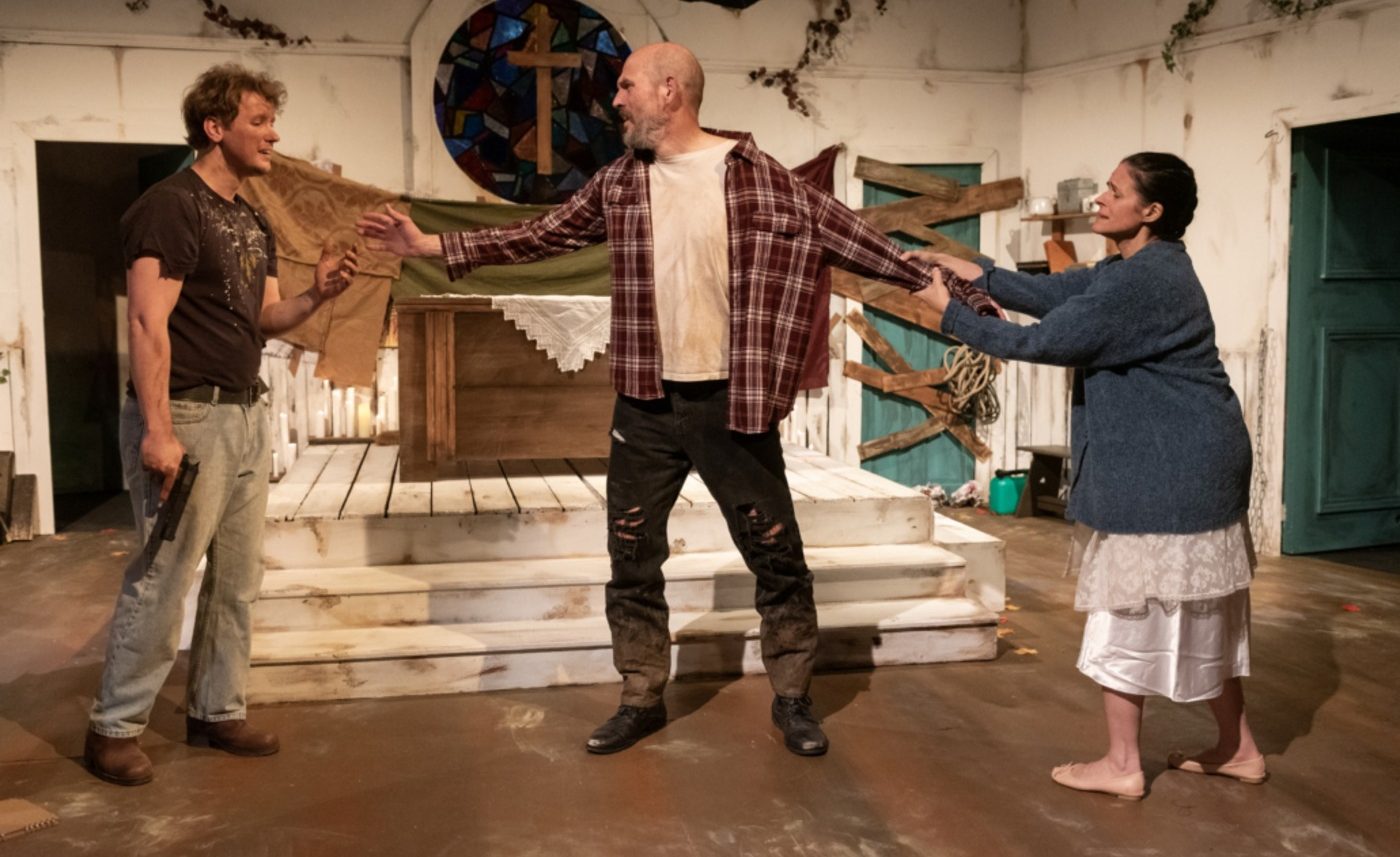Review: The Cage Protects Me at The Loft Main House
The set of The Cage Protects Me, designed by Amy Carroll and Caitlin Mills, immediately draws the audience into another world. Both a home and a terrible fortress, the events of the play unfold in a church in the ‘Old West’ ghost town of Drylake, Texas. The place is rural, isolated, decaying, messy, and make-shift, the entrances and windows boarded up with wooden planks, the insides stocked with messy piles of cluttered, worn-out possessions. The whole thing is a ‘great armoured beast’, a cage that is forced upon the characters, but also, as is slowly realised through the play, one which is chosen.
The Cage Protects Me is a ghost story written and directed by Giles Allen-Bowden. Having initially been performed at Warwick University in 2015, it has now been revised and revived for a professional showing in the Loft Theatre. The story revolves around the character of Red (played by Peter Daly-Dickson), a mentally unstable, grieving figure who has been besieged by otherworldly ‘wolves’ for a decade. His wife, Grace (played by Katie-Anne Ray), is present periodically as a lofty and distant ghost, alongside the duo ‘Sense’ and ‘Omen’, psychological manifestations of Red, a subverted take on the trope of the Angel and Devil on either shoulder.
These manifestations – one of logic and one of instinct – talk, banter, and argue throughout the play. Both wear black attire (Sense with a clean, elegant suit, Omen with a more tattered, ripped one), creating the impression of them being apart from the rest of the world. Both also act suavely, but in different ways: Sense, played by Julien Rosa, is more formal, while Omen, played by Luca Catena, is more laid-back.
During the play, reality and the supernatural slip into each other, with ‘real’ characters interacting with ghosts and manifestations. Owen Watts plays the villainous ‘Howl’, the human face of the inhuman pack, gliding gracefully onto the stage before transitioning into a monstrous rage, accentuated with beastly, guttural growls. Anna Butcher plays Élan, a newcomer to the town who is haunted by her past (personified by Thomas, played by Connor Carson), and is able to see and interact with Omen and Sense. The play contains a few flashbacks, indicated by the soft lighting and the sound of chirping, and it is only in these that we meet Jethro, played by Jack Bailey, who is one of the original Christian townsfolk.
In Red, the three are one, and it’s a sign of brilliance when one can integrate another actor’s performance into their own, so that we can see Red, Sense and Omen not just as separate, but as different parts of an unholy trinity
The two stand-out performances come from Ray and Daly-Dickson. In Grace, Ray’s sense of distance is both heart-breaking and horrifying, a spirit without the body needed to love, who despite her numbness does not want to stay in Drylake. Daly-Dickson’s performance is controlled and convincing. He is able to show a true range as Red, portraying a brokenness and trauma that produces sympathy for the hellish situation he has been trapped in. My favourite part of Daly-Dickson’s performance- and my favourite part of the play as a whole- is when elements of Rosa and Catena’s idiolects are incorporated into his portrayal of Red. In Red, the three are one, and it’s a sign of brilliance when one can integrate another actor’s performance into their own, so that we can see Red, Sense and Omen not just as separate, but as different parts of an unholy trinity.
The idea of a ‘siege’ narrative which utilises the supernatural is enticing, and it’s a premise that allows for harsh and unrelenting character examination. However, the play doesn’t allow for what draws me to this type of story: it doesn’t give the characters a lot of time to breathe
While the first act sets up numerous themes, including death, religion, abuse, and mental illness, I found some of the developments in the second act to be slightly baffling, to the point of occasionally breaking me out of the action. While the play can be applauded for the amount of ideas it touches upon, I personally would’ve enjoyed a tighter focus, dropping one or two of the themes and honing in on the rest.
I’m all for a character-driven plot within the confines of a single location. The idea of a ‘siege’ narrative which utilises the supernatural is enticing, and it’s a premise that allows for harsh and unrelenting character examination. However, the play doesn’t allow for what draws me to this type of story: it doesn’t give the characters a lot of time to breathe. As I’ve said, I would’ve preferred a narrower thematic focus, but otherwise the plot is too tight for its own good, moving quickly from one point to the next.
I would recommend watching The Cage Protects Me this Halloween season; when it shines, Allen-Bowden’s debut reminds me of Sartre’s No Exit, where the hell consists not of fire or physical torture, but of something all too human
However, the atmosphere the play creates, of present ruin and haunting pasts, is gripping. Decay and dilapidation pervades the play (“It was good as it was,” intones Jethro, distressed and agitated). I would recommend watching The Cage Protects Me this Halloween season; when it shines, Allen-Bowden’s debut reminds me of Sartre’s No Exit, where the hell consists not of fire or physical torture, but of something all too human.
The Cage Protects Me is playing at the Loft Theatre until 8 November.

Comments